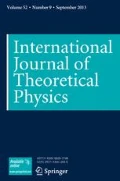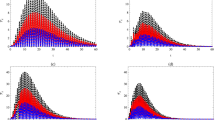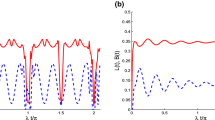Abstract
We develop an analytical solution of fractional Schrödinger equation to explain the interaction between a two-level atom and a single electromagnetic field mode inside a cavity. Based on this solution, two different cases are discussed; the first one reflects the standard Jaynes Cummings model, while the second solution gives rise to a wave equation for a dipole interacted with a field in semi-classical sense. By controlling different parameters inside cavity, the estimation degree in terms of quantum Fisher information is investigated. The obtained results show that the precision estimation increases as the detuning decreases and number of photons inside cavity increases. Moreover robust estimation is obtained for the standard Jaynes Cummings model. To measure the amount of information, a comparative study between von Neumann entropy and quantum Fisher information show the same behavior. As a result, we conclude that quantum Fisher information may detect entanglement of the interacted atom-field system.









Similar content being viewed by others
References
Nielsen, M.A., Chuang, I.L.: Quantum Computation and Quantum Information. Cambridge University Press, Cambridge (2000)
Asjad, M., Saif, F.: Engineering entanglement mechanically. Phys. Lett. A 376, 2608–2612 (2012)
Akram, M.J., Ghafoor, F., Saif, F.: Electromagnetically induced transparency and tunable fano resonances in hybrid optomechanics. J. Phys. B: At. Mol. Opt. Phys. 48, 065502, (8pp) (2015)
Haq, S., Saif, F.: Extended entanglement to quantum networks. Optik 124, 5914–5917 (2013)
Saif, F., Haq, S.: Remote entanglement for quantum networks. Optik 125, 6616–6619 (2014)
Bennett, C., Brassard, G., Crepeau, C., Jozsa, R., Peres, A., Wootters, W.: Teleporting an unknown quantum state via dual classical and Einstein-Podolsky-Rosen channels. Phys. Rev. Lett. 70, 1895 (1993)
Ekert, A.K.: Quantum cryptography based on Bell’s theorem. Phys. Rev. Lett. 67, 661 (1991)
Esmail, S., Salah, A., Hassan, S.: Statistical aspects and dynamical entanglement for a two-level atom moving on along cavity length of x-direction: atomic position distribution. Braz. J. Phys. 49, 438–448 (2019)
Ullah, S., Qureshi, H.S., Tiaz, G., Ghafoor, F., Saif, F.: Coherence control of entanglement dynamics of two-mode Gaussian state via Raman driven quantum beat laser using Simon’s criterion. Appl. Opt. 1, 197 (2019)
Rameez, I., Khosa, I., Saif, F., Bergou, J.A.: Generation of atomic momentum cluster and graph states via cavity QED. Quantum Inf. Process 12, 129–148 (2013)
Drnovšek, R.: The von Neumann entropy and unitary equivalence of quantum states. Line and Multilin Alge. 62, 12 (2014)
Helstrom, C.W.: Quantum Detection and Estimation Theory. Academic, New York (1976)
Zheng, Q., Uao, Y., Li, Y.: Optimal quantum channel estimation of two interacting qubit subject to decoherence. Eur. Phys. J. D. 68, 170 (2014)
Giovannetti, V., Lloyd, S., Maccone, L.: Quantum metrology. Phys. Rev. Lett. 96, 010401 (2006)
Boss, J.M., Cujia, K.S., Zopes, J., Degen, C.L.: Quantum sensing with arbitrary frequency resolution. Science 356, 6340 (2017)
Safranek, D.: Simple expression for the quantum Fisher information matrix. Phys. Rev. A. 97, 042322 (2018). and references therein
Zhong, W., Sun, Z., Ma, J., Wang, X., Nori, F.: Fisher information under decoherence in Bloch representation. Phys. Rev. A. 87, 022337 (2013)
El Anouz, K., El Allati, A., Metwally, N., Mourabit, T.: Estimating the teleported initial parameters of a single and two-qubit systems. Appl. Phys. B. 125, 11 (2019)
Metwally, N., Hassan, S.S.: Estimation of pulsed driven qubit parameters via quantum Fisher information. Las. Phys. Lett. 14, 11 (2017)
Pezze, L., Smerzi, A.: Entanglement, Nonlinear Dynamics, and the Heisenberg Limit. Phys. Rev Lett. 102, 100401 (2009)
Obada, A.-S.F., Abdel-Khalek, S.: Entanglement evaluation with atomic Fisher information. Physica A. 389, 891 (2010)
Bagley, R.L., Torvik, P.L.: On the fractional calculus models of viscoelastic behaviour. J. Rheol. 30, 133–155 (1986)
Odibat, Z.: Analytic study on linear systems of fractional differential equations. Comp. Math. Appl. 59, 3 (2010)
Breuer, H.-P., Petruccione, F.: The Theory of Open Quantum Systems. Oxford University Press, Oxford (2007)
Nikolai, L.: Fractional quantum mechanics and Lévy path integrals. Phys. Lett. A. 268, 298–305 (2000)
Naber, M.: Time fractional Schrödinger equation. J. Math. Phys. 45, 8 (2004)
Lu, L., Yu, X.: Time fractional evolution of the two-level system interacting with light field. Laser Phys. Lett. 14, 115202 (2017)
Zidan, N., Abdel-Hameed, H.F., Metwally, N.: Quantum Fisher information of atomic system interacting with a single cavity mode in the presence of Kerr medium. Sci. Rep. 9, 2699 (2019)
Hamada, A. -H., Nour, Z., Metwally, N.: Quantum Fisher information of two superconducting charge qubits under dephasing noisy channel. Inter. Jour. of Mod. Phys. B. 32, 22 (2018)
Metwally, N.: Fisher information of accelerated two-qubit systems. Inter. Jour. of Mod. Phys. B. 32, 5 (2018)
Chin, W., Huelga, F., Plenio, B.: Quantum metrology in Non-Markovian environments. Phys. Rev. Lett. 109, 233601 (2012)
Ming, X., Wang, X., Sun, C.P.: Quantum fisher information flow in Non-Markovian processes of open systems. Phys Rev A. 82, 042103 (2010)
Metwally, N., Hassan, S.S.: Estimation of pulsed driven qubit parameters via quantum Fisher information. Las. Phys. Lett. 14, 115204 (2017)
Lu, X.M., Sun, Z., Wang, X., Luo, S.: Broadcasting quantum Fisher information. Phys. Rev. A 87, 050302, (R) (2013)
Xiao, X., Yao, Y., Zhong, W.J., Li, Y.L., Xie, Y.M.: Enhancing teleportation of quantum Fisher information by partial measurements. Phys. Rev. A 93, 012307 (2016)
Zhong, W., Sun, Z., Ma, J., Wang, X., Nori, F.: Fisher information under decoherence in Bloch representation. Phys. Rev. A 87, 022337 (2013)
Miller, K.S., Ross, B.: An Introduction to the Fractional Calculus and Fractional Differential Equations. Wiley, New York (1993)
Salah, A., Esmail, S.: A new laplace iteration technique for solving a generalize fractional nonlinear schrodinger equation. Math. Sci. Lett. 5, 2 (2016)
El Anouz, K., El Allati, A., Metwally, N.: Teleportation two-qubit state by using two different protocols. Opt. Quant. Electron. 51, 203 (2019)
El Allati, A., Metwally, N., Hassouni, Y.: Transfer information remotely via noise entangled coherent channels. Opt. Commun. 284, 519 (2011)
Yao, F., Che, Y., Su, Y., Liang, H., Pei, J., Wang, X.: Enhancing the sensitivity of rotation in a multiatom Sagnac interferometer. Phys. Rev. A 99, 052128 (2019)
Xia, Y., Zhuang, Q., Clark, W., Zhang, Z.: Repeater-enhanced distributed quantum sensing based on continuous-variable multipartite entanglement. Phys. Rev. A 99, 012328 (2019)
Lu, X., Yu, S., Oh, C.: Robust quantum metrological schemes based on protection of quantum Fisher information. Nature Comm. 6, 7282 (2015)
Metwally, N.: Fisher information of a single qubit interacts with a spin-qubit in the presence of a magnetic field. Physica E: Low-dimen. Sys. and Nano. 100, 14–23 (2017)
Zidan, N., Abdel-Hameed, H.F., Metwally, N.: Quantum Fisher information of atomic system interacting with a single cavity mode in the presence of Kerr medium. Scien Repo. 9, 2699 (2019)
El Anouz, K., El Allati, A., Metwally, N.: Different indicators for Markovian and non-Markovian dynamics. Phys. Lett. A. 384, 5 (2019)
El Anouz, K., El Allati, A., El Baz, M.: Teleporting quantum Fisher information for even and odd coherent states. Opt. Soc. of Amer. B. 37, 1 (2020)
Acknowledgment
K. EL ANOUZ acknowledges financial support for this research from the ”Centre National pour la Recherche Scientique et Technique” CNRST, Morocco. A. El Allati acknowledges the hospitality of the Abdus Salam International Center for Theoretical Physics (Trieste, Italy).
Author information
Authors and Affiliations
Corresponding author
Additional information
Publisher’s Note
Springer Nature remains neutral with regard to jurisdictional claims in published maps and institutional affiliations.
Appendix
Appendix
The fractional derivative meaning have been established using different methods, the most popular ones are Caputo and Riemann-Liouville concepts [37, 38]. Both methods are basically defined using Riemann-Liouville integration. For any function ζ(t) of order α > 0, it is indicates as
where Γ(α) called Gamma Function [23] and Iα verify the following properties
Using the Caputo notion, the fractional derivative of ζ(t) takes the following form
The main advantage of Caputo’s methods is based on its possibility to solve the fractional derivative system with variable initial conditions. However, in order to improve the solution of linear fractional differential equations we investigate the stability properties. Consider the following fractional differential linear system,
where \(v\in \mathbb {R}^{n}\) and \(M\in \mathbb {R}^{n} \times \mathbb {R}^{n}\), moreover αi and \(\frac {\partial ^{\alpha _{i}}}{\partial t^{\alpha _{i}}}\) for i = 1, ... , n are the fractional orders and Caputo fractional derivative, respectively. If α1 = α2,.... = αn then the solution of (3) is improved in Ref. [23]. Whereas the general solution is then expressed in terms of Mittag-Leffler function, Eα(tα) as,
where ξ and u are an arbitrary constant and vector to be determined, respectively. However, Eα(s) indicates the Mittag-Leffler function of a single parameter α, it takes the following form
Substituting (26) into (25) allows to the following result
after canceling the nonzero factor, Eα(ξtα) gives rise to
where In×n represents the identity matrix of (n × n) dimension. Therefore we conclude from (29) that ξ and u indicate the eigenvalue and eigenvector of the matrix M. Finally the general solution of the linear fractional system is then given by
where, Ci (i = 1,..n) are arbitrary constants and Eα(ξitα) may be calculated from (27).
Rights and permissions
About this article
Cite this article
El Anouz, K., El Allati, A., Salah, A. et al. Quantum Fisher Information: Probe to Measure Fractional Evolution. Int J Theor Phys 59, 1460–1474 (2020). https://doi.org/10.1007/s10773-020-04415-2
Received:
Accepted:
Published:
Issue Date:
DOI: https://doi.org/10.1007/s10773-020-04415-2




